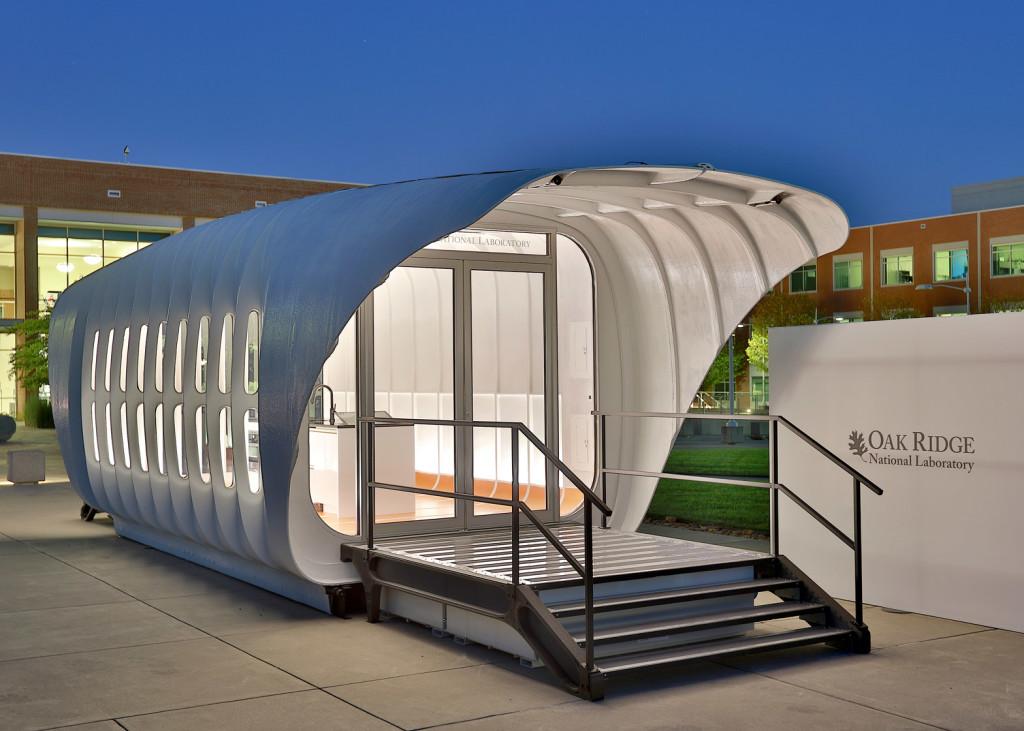Move Off the Grid with AMIE: 3D Printed Solar Home & Car Concept Debut at International Builders’ Show
 For as long as most of us can probably remember, keeping up with the Joneses has been a cultural pastime–and the ultimate stressor, keeping many running on that hamster wheel just as fast as they can go. Who has the biggest McMansion with the most expensive car and most sprawling, bright green lawn? Boasting about square footage is still a thing, but for many today it’s gone in the opposite direction as the competition to see who can live in small but amazing quarters kicks off for new–and older–generations.
For as long as most of us can probably remember, keeping up with the Joneses has been a cultural pastime–and the ultimate stressor, keeping many running on that hamster wheel just as fast as they can go. Who has the biggest McMansion with the most expensive car and most sprawling, bright green lawn? Boasting about square footage is still a thing, but for many today it’s gone in the opposite direction as the competition to see who can live in small but amazing quarters kicks off for new–and older–generations.
Moving off the grid and showing off self-sustainability with a satisfied smirk has become the ultimate in contemporary cool as many are waving the finger at tradition, society, and saying goodbye to paying big bucks for a home and the dreaded accompanying mortgage. While that may all still be fairly difficult to pull off, as more and more of us choose alternative housing and energy systems, what was once an enviable trend may become the norm.
It’s true that we see more stories about how 3D printing will help us make cool habitats to live on the moon–or Mars–than on Earth, but finally one group has thrown their hat in the ring and has been progressing further and further in their mission to make 3D printed homes for self-sustaining life here on our home planet. Oak Ridge National Laboratory, headquartered in Roane County, Tennessee, is a government agency and lab operating under the US Department of Energy. With a focus on scientific discovery, clean energy, and security, they also happen to be home to BAAM, a 3D printer capable of building enormous structures very quickly, with output of up to 100 pounds of material every hour, and the ability to print objects as large as 20 x 12 x 6 feet in size. This is the machine that is able to make not just 3D printed homes, but cars too.
Seeing themselves as bringing the construction world into the 21st century, the ORNL team partnered with both Clayton Homes and US architectural firm Skidmore, Owings & Merrill (SOM) a couple of years ago, and we’ve been following their progress as they began their journey to 3D printing homes–and the cars to match. Naming the whole concept AMIE, for Additive Manufacturing Integrated Energy project, we have followed as the team of builders and innovators has gone from concept to prototype, working their way toward making their residential energy systems an actual reality via a solar-powered structure that works with a symbiotic connection to a natural gas-powered hybrid electric vehicle.
Debuting the structure at the International Builders’ Show in Las Vegas from January 19-21, the team refers to the AMIE concept as the world’s largest 3D-printed polymer structure. Showing off how the home system works on a cycle of energy from solar to battery, and with the car and home feeding off each other, the innovative team highlights their all-in-one approach which certainly has the potential to get many of us excited about the future of dwellings. AMIE indeed carries out the intended mission to give an example of what can be done to create superior, sustainable urban environments, and encourages everyone to think not just about the way we can make, store, and user power, but also how energy can be shared between a home and a car, using both solar and natural gas.
“SOM and its partners optimized the structure’s form to reduce the amount of material used and to express three-dimensional printing’s ability to deploy complex, organic geometries,” said the SOM team.
Usage of materials is cut down on significantly in these constructions, made of 3D printed panels that can serve multiple purposes either as outside cladding, structural support, insulation, and moisture protection. Here are some other interesting details:
- The structure measures 38 feet long by 12 feet high by 12 feet wide.
- It is made up of 80% opaque panels and 20% glazing, resulting in a highly efficient enclosure.
- Solar panels on the roof fuel the battery under the building, which powers the home at night.
- The 3D printed vehicle generates its own power with a hybrid system, capable of operating from WiFi.
“The project pioneers two-way, wireless energy sharing between a 3D-printed vehicle, the power grid, and photovoltaics embedded in the structure,” said the firm.
The AMIE project also branched out into other partnerships, including the University of Tennessee and several other privately held companies.
“The innovation consortium is an excellent example of design, government, science, the university and multiple industry partners working together to push the limits of building technology and high-performance design to solve some of the world’s most urgent issues in energy and urbanism,” said SOM partners Brian Lee and Philip Enquist.
And while this isn’t the first story we’ve covered regarding 3D printed structures, it’s certainly seems to be one of the most organized, integrated, and progressive concepts out there–and one that certainly offers everything one needs in a low-profile residence, making as small a footprint as possible. Is this a structure you would interested in living in? Discuss in the 3D Printed Home & Car forum over at 3DPB.com.
Subscribe to Our Email Newsletter
Stay up-to-date on all the latest news from the 3D printing industry and receive information and offers from third party vendors.
You May Also Like
Precision at the Microscale: UK Researchers Advance Medical Devices with BMF’s 3D Printing Tech
University of Nottingham researchers are using Boston Micro Fabrication‘s (BMF) 3D printing technology to develop medical devices that improve compatibility with human tissue. Funded by a UK grant, this project...
3D Printing Webinar and Event Roundup: April 21, 2024
It’s another busy week of webinars and events, starting with Hannover Messe in Germany and continuing with Metalcasting Congress, Chinaplas, TechBlick’s Innovation Festival, and more. Stratasys continues its advanced training...
3D Printing Webinar and Event Roundup: March 17, 2024
It’s another busy week of webinars and events, including SALMED 2024 and AM Forum in Berlin. Stratasys continues its in-person training and is offering two webinars, ASTM is holding a...
3D Printed Micro Antenna is 15% Smaller and 6X Lighter
Horizon Microtechnologies has achieved success in creating a high-frequency D-Band horn antenna through micro 3D printing. However, this achievement did not rely solely on 3D printing; it involved a combination...
































